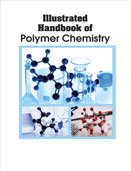Handbooks

Polymer chemistry is the study of the synthesis, characterization and properties of polymer molecules or macromolecules, which are large molecules composed of repeating chemical subunits known as monomers. Polymers are high molecular mass compounds formed by polymerization of monomers. The simple reactive molecule from which the repeating structural units of a polymer are derived is called a monomer. A polymer is chemically described by its degree of polymerization, molar mass distribution, tacticity, copolymer distribution, the degree of branching, by its end-groups, crosslinks, crystallinity and thermal properties such as its glass transition temperature and melting temperature. Polymers in solution have special characteristics with respect to solubility, viscosity and gelation. This illustrated guide introduces polymer science basics, properties, and uses.
Polymer chemistry deals with the structures, chemical synthesis and properties of polymers, primarily synthetic polymers such as plastics and elastomers. It is related to the broader field of polymer science, which also encompasses polymer physics and polymer engineering. Certain polymers, such as proteins, cellulose, and silk, are found in nature, while many others, including polystyrene, polyethylene, and nylon, are produced only by synthetic routes. In some cases, naturally occurring polymers can also be produced synthetically. An important example is natural (Hevea) rubber, known as polyisoprene in its synthetic form. Polymers that are capable of high extension under ambient conditions find important applications as elastomers. In addition to natural rubber, there are several important synthetic elastomers including nitrile and butyl rubber. Other polymers may have characteristics that enable their fabrication into long fibers suitable for textile applications. The synthetic fibers, principally nylon and polyester, are good substitutes for naturally occurring fibers such as cotton, wool, and silk. The traditional polymer materials available today, especially the plastics, are the result of decades of evolution. Their production is extremely efficient in terms of utilization of raw materials and energy, as well as of waste release. The products present a series of excellent properties such as impermeability to water and microorganisms, high mechanical strength, low density (useful for transporting goods), and low cost due to manufacturing scale and process optimization. However, some of their most useful features, the chemical, physical and biological inertness, and durability resulted in their accumulation in the environment if not recycled.
Illustrated Handbook of Polymer Chemistry is intended to provide a comprehensive coverage of the basic principles of polymer chemistry, from significant methods of molecular weight determination to the simpler mechanisms of polymerization. It examines the use of polymers and demonstrates how their properties are controlled by their molecular structure. During the last ten to fifteen years the developments in polymer science has been striking attention and experienced significant variations. From rather specialized subject intended for engineers interested in certain definite fields, it has developed into one of the fundamental disciplines common to several branches of engineering and science. To serve this purpose, the subject materials have been prepared to treat a comprehensive aspects of polymer chemistry.
Illustrated Handbook of Polymer Chemistry provides graduate and undergraduate students with an up-to-date introduction to the chemistry of macromolecular substances, including their synthesis and the properties underlying their commercial importance.